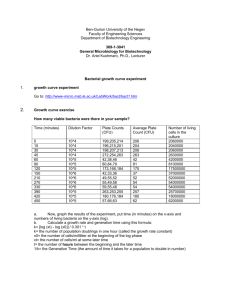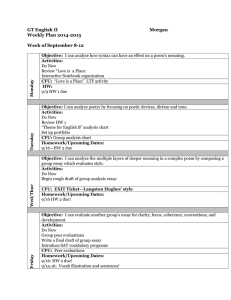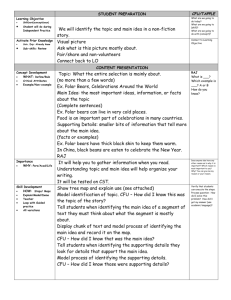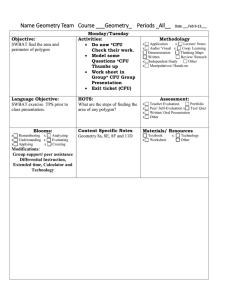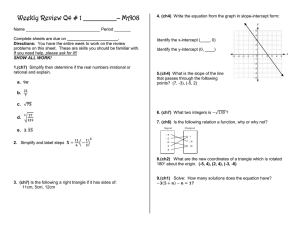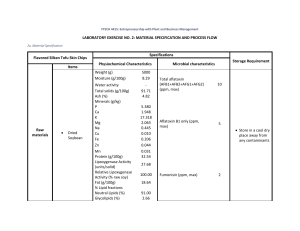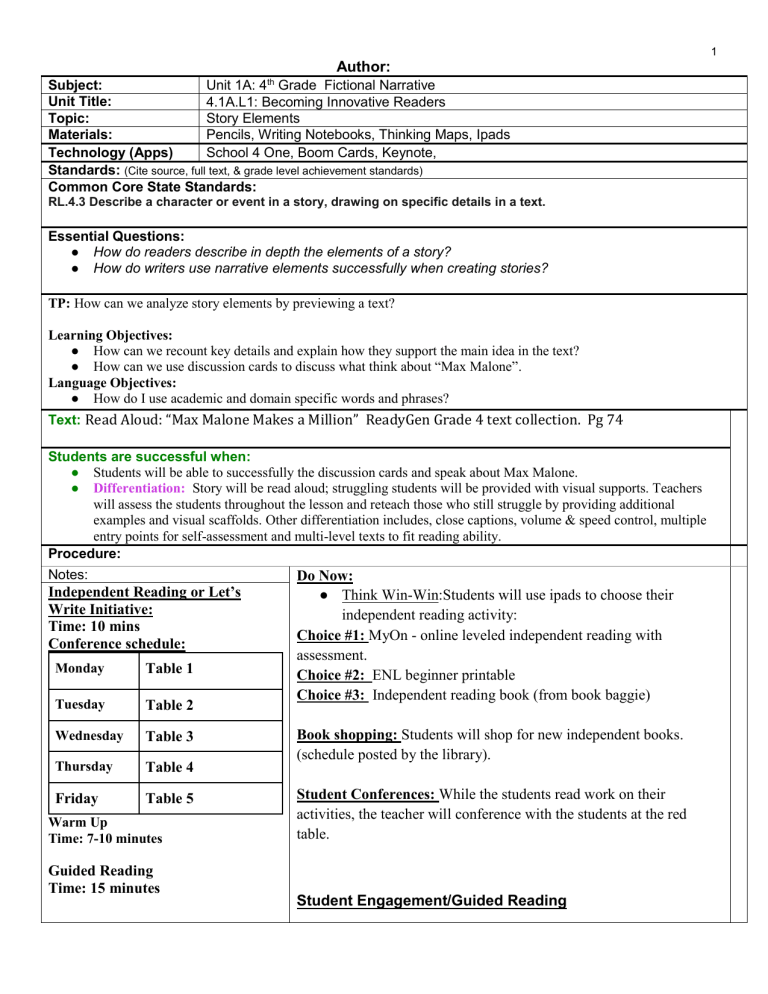
1 Author: Subject: Unit 1A: 4th Grade Fictional Narrative Unit Title: 4.1A.L1: Becoming Innovative Readers Topic: Story Elements Materials: Pencils, Writing Notebooks, Thinking Maps, Ipads Technology (Apps) School 4 One, Boom Cards, Keynote, Standards: (Cite source, full text, & grade level achievement standards) Common Core State Standards: RL.4.3 Describe a character or event in a story, drawing on specific details in a text. Essential Questions: ● How do readers describe in depth the elements of a story? ● How do writers use narrative elements successfully when creating stories? TP: How can we analyze story elements by previewing a text? Learning Objectives: ● How can we recount key details and explain how they support the main idea in the text? ● How can we use discussion cards to discuss what think about “Max Malone”. Language Objectives: ● How do I use academic and domain specific words and phrases? Text: Read Aloud: “Max Malone Makes a Million” ReadyGen Grade 4 text collection. Pg 74 Students are successful when: ● Students will be able to successfully the discussion cards and speak about Max Malone. ● Differentiation: Story will be read aloud; struggling students will be provided with visual supports. Teachers will assess the students throughout the lesson and reteach those who still struggle by providing additional examples and visual scaffolds. Other differentiation includes, close captions, volume & speed control, multiple entry points for self-assessment and multi-level texts to fit reading ability. Procedure: Notes: Independent Reading or Let’s Write Initiative: Time: 10 mins Conference schedule: Monday Table 1 Tuesday Table 2 Wednesday Table 3 Thursday Table 4 Friday Table 5 Warm Up Time: 7-10 minutes Guided Reading Time: 15 minutes Do Now: ● Think Win-Win:Students will use ipads to choose their independent reading activity: Choice #1: MyOn - online leveled independent reading with assessment. Choice #2: ENL beginner printable Choice #3: Independent reading book (from book baggie) Book shopping: Students will shop for new independent books. (schedule posted by the library). Student Conferences: While the students read work on their activities, the teacher will conference with the students at the red table. Student Engagement/Guided Reading 2 ● Teachers pull a Guided Reading group in the library area. Monday Tuesday Felix, Stacy, Jenesis, Madison, Gabriel, Gianni Jeff, Andy, Hailey, Bright Kim, Bryan, Yorceli, Shiwani, Angalie, Michelle, Elhadj, Brandon Jesus, Marc, Alex, Steven, Emily, Jeff Wednesday Anthony, Derek, Jesus, Chisom, Victoria, Eric Leanna, Regina, Stephany, Axel, Ashley, Alex A. Thursday Fiona, Melany, Miguel, Jovan, Xavier Peng, Sebastian, Melissa, Alex M. Johnny, Iker, Michelle, Kayla Friday Tenzin, Darren, Sabiha, Danielle, Jessica Zion, Ashley Coronel, Aylin Reteaching Groups (See the attached form) Groups: Yellow and Green ● These are the students who received a passing score on the the text feature task cards on Boomlearning. ● They will choose their own rotation. TEAM TALK CFU #1: After the reading in the Social Studies text book, students use discussion cards to answer this question: Why would the author include a particular text feature; is it a coincidence? ● ‘ABC strategy, agree, build, challenge ● Color coded discussion cards ● Last round sum it up. Reading Mini Lesson: Rotations ● Teachers go over each assignment and time restrainsts ● Teachers review the guiding questions for the chapter. ● Teachers go over the group work expectations. ● Teachers remind the students to be Proactive. They have to be in charge of themselves. Take the time to do what’s right no matter what is going on around you. Plan for the success you want to have. ROTATION GROUPS: Building comprehension through text features (35 minutes) BE PROACTIVE - YOU’RE IN CHARGE ● Students synergize to create a thinking map in order to understand the text more clearly. ● Students work in pairs on fact and opinion task cards ● Students use the strategy of their choice to summarize the TED talk “The Power of Disagreement” via S4O. ● Students can practice identifying tier 2 words via quizlet. ● Students read the chapter and together analyze it with guiding questions. ● Students send the finished work to School For One to be graded. ● Make sure you are PROACTIVE and not REACTIVE when working in your group: Stop and think how to respond to your classmate in a respectful way whenever you may disagree with them. (Seek First to Understand, Then to be Understood) TEAM TALK CFU #2: Students turn to their partner and discuss the group work expectations and the task at hand. This helps the teachers monitor student understanding of the lesson. ● Put First Things First - Get your work done first, check it again to make sure all the parts are complete. Once you are done you are then able to go on Imagine ELA or MYON. CFU #3: As students work in groups the teachers circulate among groups and students clarifying the text and posing challenging questions to stimulate thinking and further the discussion. Group: Red ● These are the students who did not receive a passing grade on the text feature cards. CFU #4 ASSESS YOURSELF: Students will self assess their writing progress by identifying their place in the writerly life flow map. With completion of all three brainstorming activities, students 3 ● Students struggle with identification and interpretation of the text feature. ● Students can attempt text features text cards again for gem points or work cooperatively to complete the scavenger hunt. Students who need additional help (Will be filled out during the lesson) can create a vision board using keynote to create a dynamic visual representation of their ideal living situation. Sharing and Reflecting CFU#5 ➢ Reflect and Adjourn ➢ Share & Discuss: Groups present their summaries to class. ➢ Students reflect on groups work: What are the glows and grows? ➢ Students set a goal for improvement for next group work. EXIT TWEET:CFU #6 ➢ Students respond to the essential question for the lesson: Clarifying Misconceptions: Students may have difficulty with certain compare and contrast signal words. Review a list of words using signal word sheet. Eliminating barriers to instruction: 1. Remind students that comparing is only finding the similarities. 2. What thinking map can help us notice the differences between these two animals (prompt using thinking map anchor charts). Leader In Me Connection Higher Order Questions: ➢ DOK L1 -What is the genre of the text? -Can you name any text features you see? ➢ DOK L2 What thinking map can we use to organize our work? How can we contrast fact and opinion? ➢ DOK L3 Why is it important to disagree? -What is the theme of the video? DOK L4 ● Begin With the End in Mind: When we read we look for example in the story to support our opinions. ● Put First Things First: Be prepared. ● Think Win-Win: Come to school prepared, make the teacher happy. Take responsibility for your work, your group is happy and productive, You feel good about yourself and you get a good grade! Students with IEPs ● None as of 12/2018 Students with IEPs (4-215) ● None as of 12/2018 Commanding ELLs only): 4 What does your vision board say about you? What would a stranger assume about you if they saw your vision board for the first time? Share & Reflecting: Time: 10 minutes Differentiation: ● Teacher circulates the room and clarifies misconceptions. ● Use of examples (Groups 1 & 2) ● Teacher works with individual students who are struggling or pulls small groups to reteach the text feature lesson, depending on the level of understanding and on the assessment. Specific accommodations for ENL Students. Accommodation (ESL/SPED) – charting, modeling, and drawing throughout lesson. Accommodations SPED/ELL: ➢ Repeat directions and questions for auditory learners. ➢ Clarifying phrases in the text ➢ Team talks to help with comprehension ➢ Self Reflection tool ➢ Small group instruction ➢ Repetition Leaders: Students seated in their “homeroom” seats are categorically placed based on recent assessments. Each table has a Writing Leader & Second (in command), Comprehension leader and spelling leader. Each table is front loaded with student who perform above grade level in literacy specific areas. These leaders often lead during reciprocal teaching and will buddy up with students at my request. ● Purpose of student leaders: “to enforce the “ask 3 before me” strategy for asking questions. ● To allow students to receive immediate help and clarification. ● To manage a large group of students who require individual attention. ● To challenge the top students. “If you can teacher others, than you have mastered the skills taught in class”.
